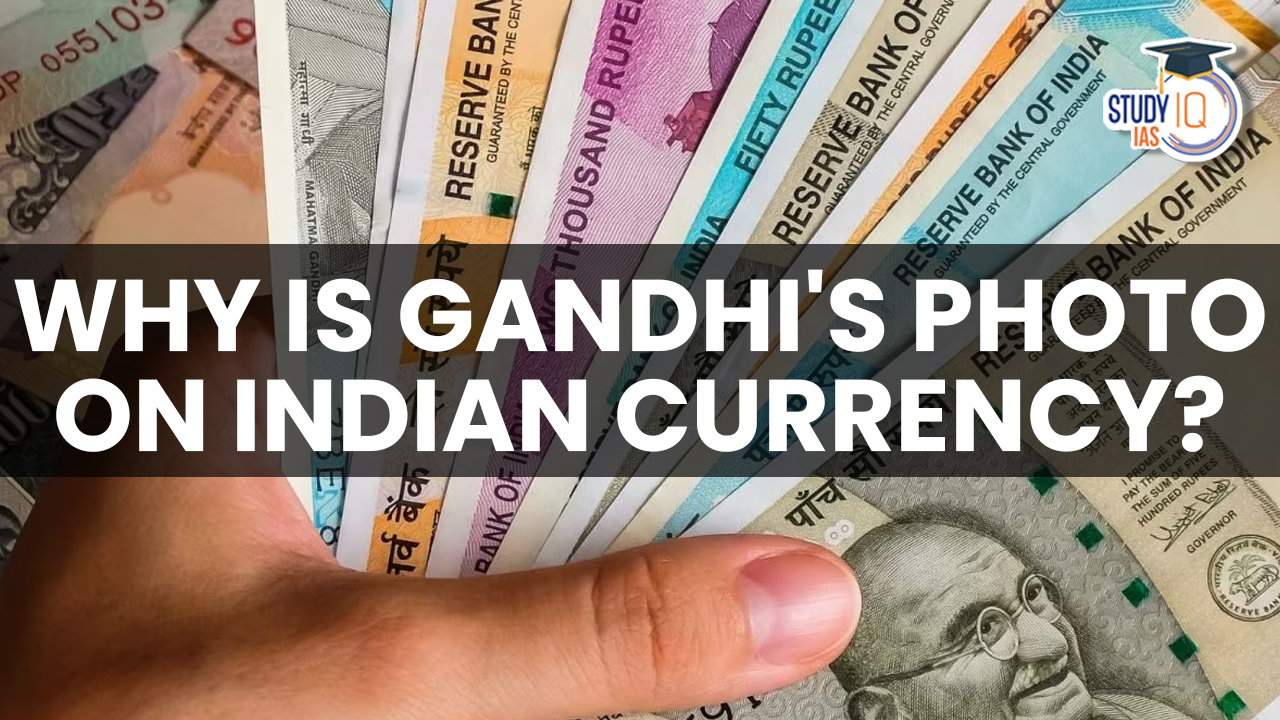Table of Contents
Mahatma Gandhi and Indian Currency: Origin to Modern Time
In 2016, the ‘Mahatma Gandhi New Series’ of banknotes was introduced by the RBI. Gandhi’s portrait remained a central feature, but the notes also featured the Swachh Bharat Abhiyan logo and additional security features.
| Topic | Details |
| Origins of Gandhi’s Image on Currency | Gandhi’s image on Indian currency is a cut-out from a 1946 photograph, standing with Lord Frederick William Pethick-Lawrence. The photographer’s identity remains unknown. |
| First Appearance on Currency | Gandhi first appeared on Indian currency in 1969 in a special series commemorating his 100th birth anniversary. |
| 1987 Appearance | In October 1987, a series of Rs 500 currency notes featuring Gandhi was introduced. |
| Early Days of Independent India | After independence in 1947, for a short time, currency notes still had King George VI’s image, a holdover from colonial times. |
| Change in 1-Rupee Note Design (1949) | In 1949, the 1-rupee note design was changed, replacing King George with the Lion Capital of Ashoka Pillar at Sarnath. |
| Choosing Symbols for Independent India | Discussions considered replacing King George’s portrait with Gandhi’s, but the final choice was the Lion Capital at Sarnath. |
| Gandhi Becomes Permanent | In the 1990s, due to security concerns, Mahatma Gandhi’s image was chosen as it was harder to counterfeit human faces. The ‘Mahatma Gandhi Series’ was introduced in 1996 with enhanced security features. |
| Modern Times (2016) | In 2016, the ‘Mahatma Gandhi New Series’ of banknotes was introduced, featuring Gandhi’s portrait along with additional security features and the Swachh Bharat Abhiyan logo. |
Read More: Why Did Nathuram Godse Kill Gandhi?
Why Mahatma Gandhi’s Photo on Indian Currency?
The decision to place the photo of Mahatma Gandhi on Indian currency notes is deeply rooted in the historical and political context of India’s struggle for independence. The story behind this choice involves significant events and deliberations that reflect the nation’s acknowledgement of Gandhi’s paramount role in shaping its destiny.
Major Events After Independence
- Post-Independence Currency Redesign (1947): After gaining independence from British rule in 1947, India sought to establish its identity in various ways, including the redesign of its currency. The task of selecting a suitable image for the currency notes was crucial, as it needed to encapsulate the spirit of the nation’s hard-fought freedom.
- Gandhi’s Symbolic Leadership: Mahatma Gandhi was the undisputed leader of the Indian independence movement. His philosophy of non-violence and civil disobedience resonated with people across the country. The Indian National Congress, the leading political party at the time, recognized Gandhi as the symbolic father of the nation.
- Gandhi’s Role in Nation Building: Beyond the struggle for independence, Gandhi was viewed as a visionary leader who could guide the newly independent India in its journey toward nation-building. His emphasis on self-reliance, rural development, and social harmony made him a natural choice for representation on the currency.
- Father of the Nation Title: In 1947, shortly after India gained independence, the Indian Constituent Assembly officially adopted the title “Father of the Nation” for Mahatma Gandhi as a mark of respect for his leadership and principles. This title solidified Gandhi’s status as an iconic figure in the nation’s history.
- Gandhi’s Assassination (1948): The tragic assassination of Mahatma Gandhi in 1948 further elevated his status in the eyes of the nation. The decision to feature Gandhi on the currency notes gained added significance as a way to honour his memory and immortalize his contributions.
- Designing the Currency Notes: The process of designing the currency notes involved a careful selection of elements that embodied the essence of India. Mahatma Gandhi’s image was chosen not just for its historical significance but also for its ability to inspire and unify a diverse population.
- Inclusion in Modern Currency Series: Over the years, as India introduced new currency series and denominations, the tradition of featuring Mahatma Gandhi’s image on the notes continued. It became a symbol of continuity, reflecting the enduring impact of his ideals on the nation.
- Educational and Inspirational Purpose: Gandhi’s image on the currency notes serves not only as a symbol of national pride but also as an educational tool. It introduces citizens, especially the younger generation, to the history of the independence movement and the principles that continue to shape the country.
Story of Mahatma Gandhi’s Portrait on Indian Banknotes
The story of Mahatma Gandhi on Indian money is interesting and shows how India’s identity and values changed after it became independent.
Origins of Gandhi’s Image on Indian Currency
The image of Mahatma Gandhi that we see on Indian currency notes isn’t a drawing or painting; it’s a cut-out from a photograph taken in 1946. In this photo, Gandhi is standing with British politician Lord Frederick William Pethick-Lawrence, and it captured Gandhi’s smiling expression, which was seen as the most suitable for the currency. Interestingly, the photographer’s identity and the person who selected this specific photo remain unknown.
When Did Gandhi First Appear on Indian Currency?
Gandhi first appeared on Indian currency notes in 1969. This was done through a special series of notes created to commemorate his 100th birth anniversary. These notes featured Gandhi along with the Sevagram Ashram in the background. In October 1987, another series of currency notes, this time of Rs 500 denomination, also featured Gandhi.
Early Days of Independent India
When India became independent in 1947, for a few months, the Reserve Bank of India (RBI) continued to use currency notes that had the image of King George VI, a relic from the colonial period. In 1949, the government of India introduced a new design for the 1-rupee note. Instead of King George, the note had a symbol of the Lion Capital of Ashoka Pillar at Sarnath in its watermark window. This was the first step towards creating a new identity for independent India.
Choosing Symbols for Independent India
During this time, discussions were held on what symbols should represent independent India in its currency. Initially, there was a suggestion to replace the King’s portrait with that of Mahatma Gandhi. Designs were even prepared for this change. However, the final decision shifted towards using the Lion Capital at Sarnath instead of Gandhi’s portrait. So, the new design of notes continued along earlier lines.
Gandhi Becomes a Permanent Feature
By the 1990s, the RBI felt that the security features on the currency notes were not strong enough to prevent counterfeiting, especially with the advancements in printing technology. They believed that it would be easier to forge inanimate objects compared to a human face.
Mahatma Gandhi was chosen because he had a strong national appeal, and in 1996, a new series of notes called the ‘Mahatma Gandhi Series’ was introduced. These notes included enhanced security features like a windowed security thread, latent image, and intaglio features for the visually impaired.
Mahatma Gandhi’s Presence on Indian Currency Significance
Mahatma Gandhi’s presence on Indian currency notes is a symbol deeply intertwined with the country’s journey towards independence and its values of non-violence, self-reliance, and social harmony. His image serves not only as a reminder of India’s struggle for freedom but also as an enduring source of inspiration for its citizens. From its initial inclusion in the commemorative series to becoming a permanent fixture in modern currency, Gandhi’s image continues to represent the nation’s identity, heritage, and commitment to the principles he championed. It encapsulates the essence of India’s history, values, and aspirations in the modern era.


 TALASH Initiative: Objective, Key Featur...
TALASH Initiative: Objective, Key Featur...
 Custodial Deaths in India, Types, Issues...
Custodial Deaths in India, Types, Issues...
 MPPSC FSO Recruitment Notification 2025 ...
MPPSC FSO Recruitment Notification 2025 ...





















